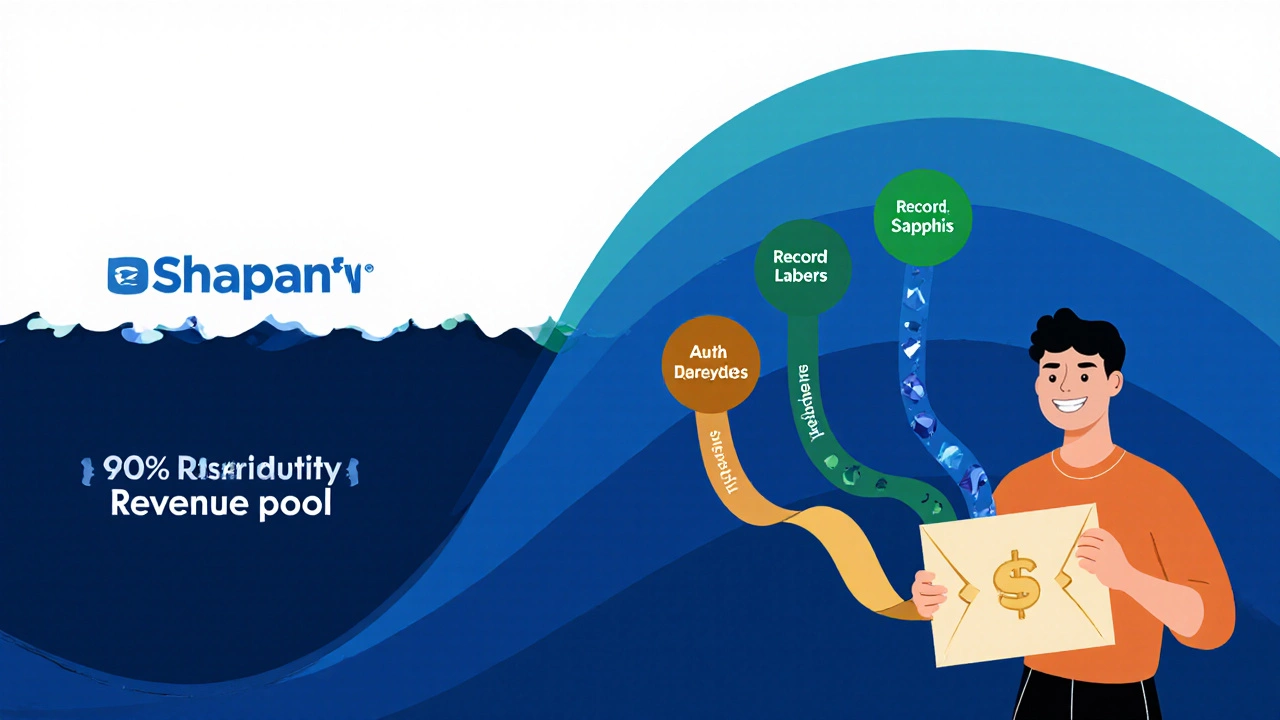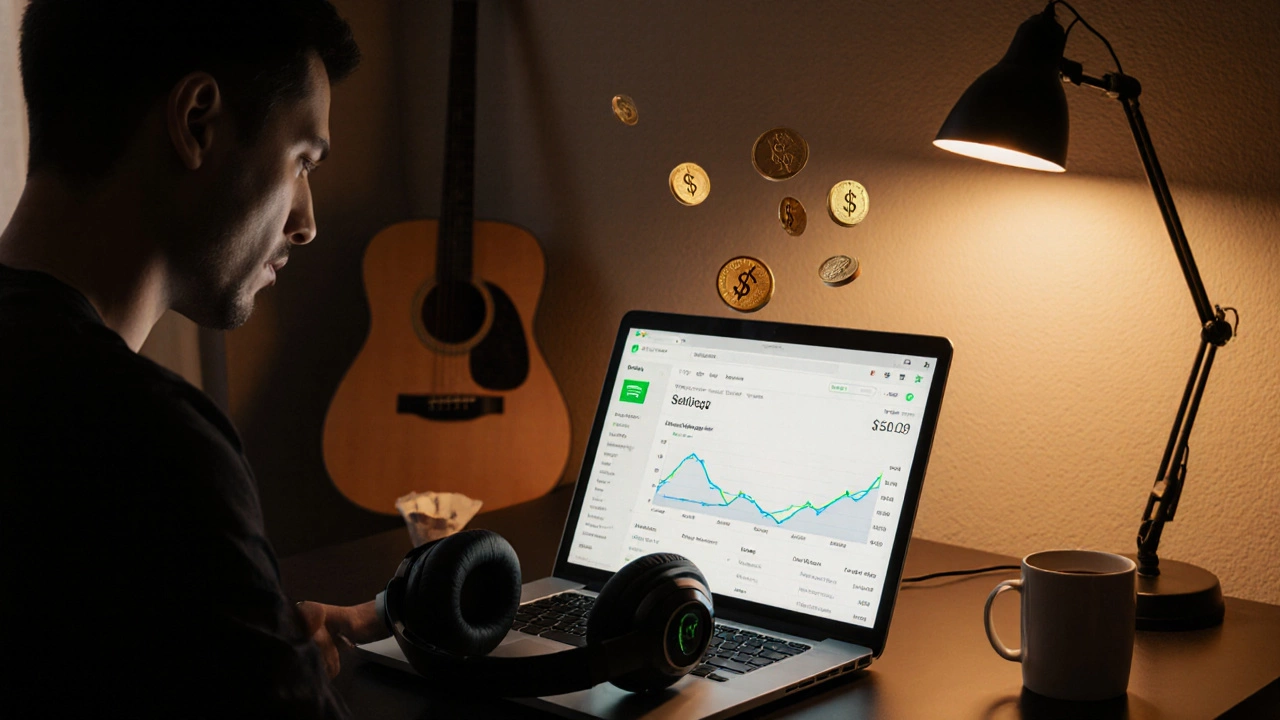Spotify Royalty Calculator
How This Calculator Works
Estimate your Spotify earnings based on real-world factors. Spotify pays between $0.003-$0.005 per stream, but your actual earnings depend on:
- Percentage of premium streams (vs. ad-supported)
- Your rights structure (independent vs. label deal)
- Geographic distribution of streams
Enter your streaming data and click "Calculate Earnings" to see your estimated royalties.
You've probably heard that streaming services pay pennies per play, but the exact numbers and the process behind them can feel like a myth. This article cuts through the fog and shows exactly how Spotify calculates and distributes royalties to artists, songwriters, and right‑holders. By the end, you’ll know what a stream is worth, which factors push that number up or down, how you actually receive the money, and what you can do to make those pennies add up.
Key Takeaways
- Spotify’s royalty pool is shared among all rights‑holders; average per‑stream earnings range from $0.003 to $0.005.
- Labels, distributors, and performance‑rights organisations each take a cut before you see a cent.
- Getting paid requires a digital distributor and registration with a PRO (e.g., ASCAP, BMI, PRS).
- Higher engagement, playlists, and regional streams can boost your share.
- Other platforms like Apple Music and YouTube Music pay differently, so diversifying is key.
How Spotify Pays Artists
Spotify operates on a pro‑rata model. Every month the service tallies its total revenue-from premium subscriptions and ad‑supported listening-into a single pool. That pool, after Spotify’s 30% cut, is divided among rights‑holders based on their share of total streams worldwide. In practice, the flow looks like this:
- Revenue collection: Premium fees, ad revenue, and occasional licensing deals feed the royalty pool.
- Spotify’s share: Roughly 30% is retained for operating costs and profit.
- Distributor & label cuts: The remaining 70% is forwarded to record labels, distributors, and performance‑rights organisations (PROs) according to contractual splits.
- Artist payout: After those deductions, the final amount lands in the artist’s bank account via the distributor.
Because the pool is split proportionally, a track that garners 1% of all Spotify streams in a month will receive roughly 1% of the available royalty money-not a fixed rate per play.

The Math: What Does a Stream Actually Earn?
The exact figure fluctuates monthly, but most industry reports from 2024‑2025 place the average Spotify stream at between $0.003 and $0.005. That means 1,000 streams might net you $3-$5, before any intermediary fees.
| Platform | Average payout per stream | Typical payout frequency |
|---|---|---|
| Spotify | $0.003-$0.005 | Monthly |
| Apple Music | $0.006-$0.008 | Monthly |
| YouTube Music | $0.0015-$0.0025 | Quarterly |
These numbers are averages. Your actual earnings can be higher if you command a larger share of streams, get a better contract, or operate in territories with higher subscription fees.
Factors That Influence Your Share
- Rights‑holder structure: Signed artists with major labels often split royalties 50/50 or worse, while independents using a distributor can keep 80-90% of the post‑Spotify amount.
- Geographic mix: Streams from premium‑only markets (e.g., US, Western Europe) generate more revenue per play than ad‑supported regions.
- Playlist placement: Getting on an official Spotify editorial playlist can dramatically increase stream volume and thus your proportion of the pool.
- Release timing: New releases benefit from algorithmic boosts, leading to a front‑loaded spike in earnings.
- Song length: Tracks longer than 30 seconds count as a full play only after 30 seconds of listening, so shorter, high‑repeat tracks can improve stream counts.
Getting Paid: The Practical Steps
Spotify never sends money directly to the artist. Instead, the payout travels through a chain of intermediaries. Here’s the checklist you need to follow:
- Choose a digital distributor: Companies like DistroKid, TuneCore, CD Baby, or Amuse act as your label. They upload your music to Spotify and collect the royalty share.DistroKid charges an annual fee, while CD Baby takes a per‑release commission.
- Register with a PRO: Performance‑rights organisations (ASCAP, BMI, PRS, etc.) collect publishing royalties for songwriters. Without this registration you’ll miss the songwriter’s cut.
- Verify your payment details: In the distributor’s dashboard, input your bank account (or PayPal) and tax information. Most distributors pay out monthly once the threshold (usually $10-$50) is reached.
- Monitor your streams: Use Spotify for Artists to track numbers, demographic data, and playlist adds. Spotting trends helps you negotiate better contracts.
When all the pieces are in place, you’ll see a line‑item called “Spotify Stream Royalty” on your distributor’s monthly statement.

Boosting Your Spotify Income
Even if the per‑stream rate looks tiny, there are proven tactics to stretch every penny:
- Focus on playlists: Pitch to curators, both official and independent. A placement on a 500,000‑listener playlist can equal hundreds of thousands of streams.
- Engage fans on social: Use TikTok, Instagram Reels, or YouTube Shorts to drive listeners directly to Spotify. The more you turn casual browsers into repeat streamers, the larger your share.
- Release strategically: Drop singles every 4-6 weeks to keep the algorithm’s “new music” boost alive.
- Bundle merchandise: Offer limited‑edition merch that includes a Spotify code, encouraging fans to add your track to their libraries.
- Collect all rights: Ensure you own both the master recording and publishing. Owning both means you capture the full royalty, not just the artist’s slice.
Alternatives & Complementary Revenue Streams
Relying solely on Spotify is risky. Here are other income sources that most artists blend with streaming royalties:
- Direct fan support: Platforms like Patreon or Bandcamp let fans subscribe or buy music without intermediary cuts.
- Sync licensing: Getting your track placed in ads, movies, or video games can yield flat fees far above streaming revenue.
- Live performances: Even virtual concerts now generate ticket sales and merchandise.
- Other streaming services: Apple Music, Amazon Music, and Tidal often pay higher per‑stream rates; uploading everywhere maximizes total earnings.
Think of streaming as a “baseline” income-steady, predictable, but low per unit. Layer it with higher‑margin activities to build a sustainable career.
Frequently Asked Questions
How often does Spotify pay out?
Payments are calculated monthly, but most distributors release the money to your bank account after the month’s data is finalized, usually within 30-45 days.
Do I need a record label to get paid?
No. Independent artists can use a digital distributor to upload music and collect royalties directly.
Why do some artists report earning more per stream?
Higher earnings usually come from a larger share of premium‑only streams, favorable contract terms, or owning both master and publishing rights, which captures multiple royalty streams.
Can I see exactly how much each of my songs earned?
Your distributor’s dashboard will break down earnings by track, territory, and date once the data is uploaded. Spotify for Artists shows raw stream counts but not the dollar amount.
Is it better to focus on playlists or on releasing many songs?
Both strategies work together. Playlists amplify the reach of each release, while frequent releases keep you in algorithmic recommendation cycles.





